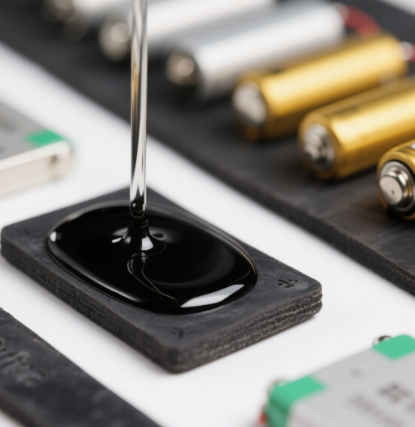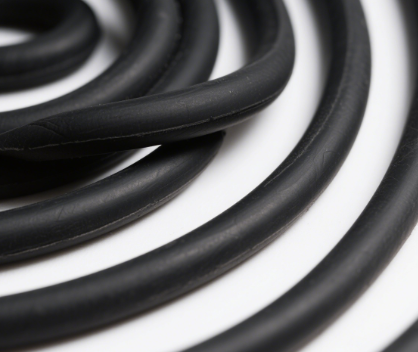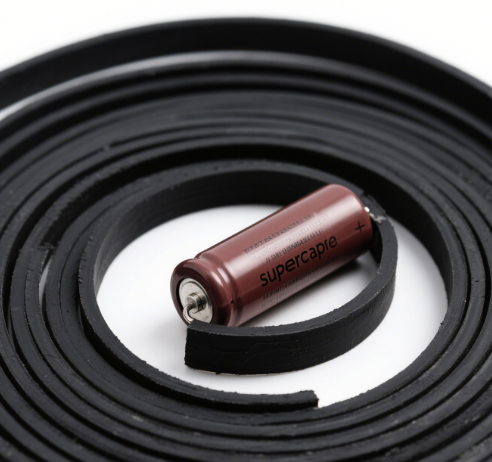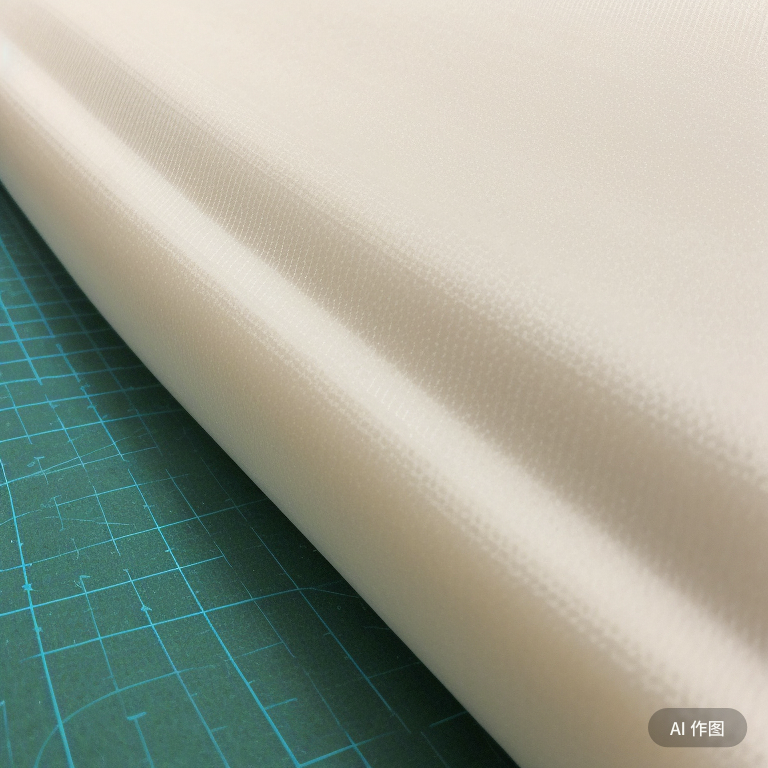conductive rubber for solid-state batteries
 The conductive rubber for solid-state batteries is a new type of solid-state electrolyte material, which is formed by compounding conductive fillers (such as carbon black, graphene, ionic liquids, etc.) with rubber matrices (such as silicone rubber and ethylene propylene diene monomer rubber). It has the characteristics of high ionic conductivity, mechanical flexibility, and chemical stability. The following analysis is carried out from aspects such as technical principles, research progress, performance advantages, commercialization prospects, and challenges:
The conductive rubber for solid-state batteries is a new type of solid-state electrolyte material, which is formed by compounding conductive fillers (such as carbon black, graphene, ionic liquids, etc.) with rubber matrices (such as silicone rubber and ethylene propylene diene monomer rubber). It has the characteristics of high ionic conductivity, mechanical flexibility, and chemical stability. The following analysis is carried out from aspects such as technical principles, research progress, performance advantages, commercialization prospects, and challenges:
- Technical Principles and Material Design
Conductive rubber mainly serves as a solid-state electrolyte in solid-state batteries, and its core function is to conduct lithium ions and isolate the positive and negative electrodes. Different from traditional liquid electrolytes, conductive rubber achieves ion transport through the following mechanisms:
Three-dimensional Conductive Network: The conductive fillers (such as graphene and ionic liquids) embedded in the rubber matrix form continuous ion channels, promoting the migration of lithium ions. For example, the rubber electrolyte developed by the Georgia Institute of Technology, through a 3D interconnected plastic crystal phase structure, achieves a high ionic conductivity of 2.7×10⁻⁴ S/cm at room temperature.
Chemical Cross-linking and Plasticization: Through vulcanization or polymerization processes, the rubber matrix forms an elastic network. At the same time, ionic liquids or small-molecule plasticizers (such as carbonates) are introduced to reduce the crystallinity of the polymer and improve the mobility of chain segments, thereby enhancing ion conduction.
Interface Adaptability: The high elasticity of rubber can adapt to the volume changes of the lithium metal anode during the charging and discharging processes, reduce interface stress, and inhibit the growth of lithium dendrites. For example, the rubber-derived electrolyte developed by the team from Beijing University of Chemical Technology maintains close contact with the lithium metal anode through a chemical cross-linking network, with a cycle life of more than 350 times.
- Research Progress and Typical Cases
Breakthrough by the Georgia Institute of Technology:
The rubber-based solid-state electrolyte developed by this team is compounded by an elastomer (such as silicone rubber) and a lithium salt. Through a 3D structure design, it achieves high ionic conductivity (2.7×10⁻⁴ S/cm) and mechanical toughness. The all-solid-state battery jointly developed with SK Innovation has an energy density of 410 Wh/kg, a cycle life that is doubled, and can still operate stably at a low temperature of – 30℃.
Rubber-derived Electrolyte of Beijing University of Chemical Technology:
The rubber-derived electrolyte prepared by the vulcanization method, through the chemical cross-linking network with the introduction of ionic liquid segments, achieves a room-temperature ionic conductivity of 2.7×10⁻⁴ S/cm and maintains stable cycling under a high areal capacity (4.7 mAh/cm²) and a high current density (4.7 mA/cm²).
Conductive Rubber as a Current Collector:
Some studies have attempted to use conductive rubber as a current collector for batteries to replace traditional metal materials. For example, in a patented technology, a composite conductive rubber (such as ethylene propylene rubber + acetylene black) is used as a current collector, which is both lightweight and highly conductive and is suitable for thin solid-state batteries.
III. Performance Advantages and Application Potential
High Safety:
Solid-state electrolytes completely avoid the leakage risk of liquid electrolytes, and the high elasticity of rubber can inhibit the penetration of lithium dendrites, reducing the probability of thermal runaway. For example, the rubber electrolyte of the Georgia Institute of Technology can still operate stably at a high voltage of 4.5V without the risk of short circuits.
Mechanical Flexibility:
The elasticity of rubber enables it to adapt to the volume changes of the battery during the charging and discharging processes and reduce interface failures. For example, the rubber electrolyte of Beijing University of Chemical Technology still maintains a capacity retention rate of 94% after repeated deformations.
Low-temperature Performance:
Rubber-based electrolytes can still maintain high ionic conductivity at low temperatures (such as – 30℃), while traditional polymer electrolytes (such as PEO) need to be heated to above 60℃ to work. For example, the capacity retention rate of the rubber electrolyte of the Georgia Institute of Technology at – 30℃ reaches 57%.
Cost and Environmental Protection:
Rubber materials have a wide range of sources, a simple manufacturing process (such as low-temperature polymerization), and can be recycled. They have a cost advantage compared with sulfide or oxide electrolytes. For example, the manufacturing cost of the rubber electrolyte of the Georgia Institute of Technology is only 1/5 of that of traditional inorganic electrolytes.
- Commercialization Prospects and Challenges
Commercialization Progress:
Enterprise Cooperation: SK Innovation and the Georgia Institute of Technology have cooperated to develop rubber electrolytes and plan to achieve mass production of all-solid-state batteries in 2025.
Technical Routes: Domestic enterprises such as Ganfeng Lithium Battery and Contemporary Amperex Technology Co., Limited (CATL) are also laying out rubber-based solid-state electrolytes, and it is expected that they will be installed in vehicles after 2030.
Patent Layout: Enterprises such as Dongguan Leizidun have applied for patents for high-temperature-resistant conductive rubber, paving the way for the application of solid-state batteries.
Technical Challenges:
Insufficient Ionic Conductivity: The room-temperature ionic conductivity of rubber-based electrolytes (about 10⁻⁴ S/cm) is still lower than that of sulfide electrolytes (10⁻³ S/cm), and it is necessary to improve it through the doping of nanoscale fillers or the optimization of composite structures.
Interface Impedance: The interface contact resistance between rubber and electrodes is relatively high, and it is necessary to improve it through surface modification (such as coating a LiPON layer) or the introduction of an intermediate buffer layer.
Long-term Stability: Rubber may degrade during the cycling process, and it is necessary to enhance its durability through chemical cross-linking or the addition of antioxidants.
Market Potential:
The market size of conductive rubber in all-solid-state batteries is expected to reach 1.79 billion US dollars in 2030, mainly applied in the fields of electric vehicles, energy storage, and aerospace. For example, NIO plans to accelerate the commercialization of solid-state batteries through the battery swap mode, and the conductive rubber electrolyte can improve the low-temperature performance and safety of the batteries.
- Comparison with Other Solid-state Electrolytes
Material Type Ionic Conductivity (S/cm) Mechanical Properties Cost Commercialization Progress
Rubber-based 10⁻⁴–10⁻³ High elasticity Low Laboratory stage (mass production in 2025)
Sulfide 10⁻³–10⁻² Brittle High Toyota and QuantumScape are laying out
Oxide 10⁻⁶–10⁻⁴ Rigid Medium BYD and CATL are in the pilot stage
Polymer (PEO) 10⁻⁶–10⁻⁴ Flexible Low Already in small-scale application
Comparison Conclusion: Rubber-based electrolytes have advantages in cost and mechanical properties, but their ionic conductivity and long-term stability still need to be improved, and they are suitable for the mid-to-low-end market; sulfide electrolytes have excellent performance but high costs and are suitable for high-end applications; oxide and polymer electrolytes are in an intermediate position.
- Future Development Directions
Material Optimization:
Nanoscale Fillers: Introduce nanomaterials such as graphene and MXenes to construct a three-dimensional conductive network and improve ionic conductivity.
Composite Structure: Compound rubber with sulfides/oxides to form an electrolyte with both rigidity and flexibility, taking into account both performance and cost.
Interface Engineering:
In-situ Polymerization: Polymerize the rubber electrolyte directly on the surface of the electrode to form a closely contacting interface.
Buffer Layer Design: Introduce ultra-thin coatings such as LiPON and Li3InCl6 to reduce interface impedance.
Manufacturing Process:
3D Printing: Achieve the integrated molding of the electrolyte and the electrode to improve production efficiency.
Roll-to-roll Process: Develop continuous production technology to reduce large-scale manufacturing costs.
Conclusion
As a core material for solid-state batteries, conductive rubber, with its high safety, mechanical flexibility, and low-temperature performance, has become an important candidate for the next generation of battery technology. Although it faces challenges in ionic conductivity and long-term stability, through material innovation and interface engineering, it is expected to gradually achieve commercialization after 2025, promoting the transformation of the electric vehicle and energy storage fields.
















